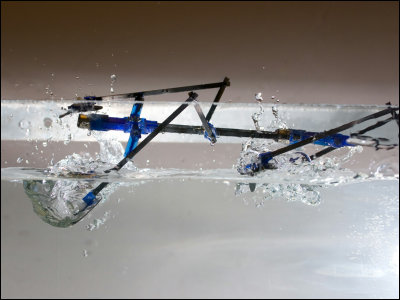Insect-sized robot "RoboBee" succeeds in jumping off the surface of the water like a rocket with an epoch-making mechanism

An insect-sized robot developed by Harvard University "RoboBeeSo farStick to the surface of thingsJumping into the water from the state of flying in the skyTo swimIt was successful in saying. According to the presentations by Harvard University, in the past research, "The surface tension interferes and does not leave the surface of water" was left as a problem, but according to the presentation by Harvard University, by using a breakthrough structure, RoboBee I succeeded in clearing the task.
New Robo Bee flies, dives, swims and explodes out the of water | Harvard John A. Paulson School of Engineering and Applied Sciences
https://www.seas.harvard.edu/news/2017/10/new-robobee-flies-dives-swims-and-explodes-out-of-water
Autonomous Flying Microrobots (RoboBees)
https://wyss.harvard.edu/technology/autonomous-flying-microrobots-robobees/
Robot bees can fly, swim, and dive out of water using tiny rockets - The Verge
https://www.theverge.com/2017/10/25/16544996/robot-bees-harvard-fly-swim-water-rocket
RoboBee is an insect-sized robot that Harvard University is researching and developing since 2013. According to the research team, this RoboBee is "about half the size of a paper clip and weighs one tenth of a gram".

Vehicles and robots that freely move around both underwater and in the air are often found in SF and others, but in reality, huge wings are required to fly around the air, whereas to swim underwater, resistance is minimized It was deemed to be extremely difficult to develop, as it is necessary and large wings become an obstacle. Meanwhile, researchers at Harvard University are one of seabirds "Punctu"I have developed RoboBee that can move around in the air and underwater with ideas.

At the time of announcement in 2015, although RoboBee was in the water from the air, the surface tension disturbed because of its lightness and smallness, and it was not able to fly again from underwater into the air. In addition, you can see how RoboBee enters underwater from the following article.
Robot "RoboBee" capable of flying the sky and swimming underwater though it is an insect size - GIGAZINE

However, research is underway, finally RoboBee is able to jump out in the air out of the water. You can see how it looks from below.
Aerial-Aquatic Microrobot - YouTube
This evolved RoboBee. The appearance has also changed considerably.

For lightly small RoboBee, the surface tension when jumping out from the water into the air is as high as 10 times its own weight. Professor Robert Wood, who is doing research, told RoboBee that the surface tension of water was "like a wall that can not break through".

The evolved RoboBee has something like a small box around the main body, once it gets in the water it gathers water in this box.

Some box has entered electric plates, is a mixed gas of hydrogen and oxygenOxygen hydrogen gasTo increase the buoyancy, push the feathers above the surface of the water. This mechanism allows you to start flapping without breaking the feathers.

Oxygen hydrogen is flammable, so when ignition occurs here ...

RoboBee jumps high in the air just as when the rocket is fired.

Looking at the slow and like this. RoboBee floats on the surface of the water with only feathers put underwater.

A small explosion occurred ......

The floating body floats up.

Looking from the side like this.

Splashing happens ......

It is jumping up.

It was RoboBee whose shape changed considerably from the former model, but this was to create an epoch-making structure that "generates water with water as a raw material, adds buoyancy and launches rockets as fuel". However, since the new RoboBee can not fly, how to clear this place will become a subject of future research.

Related Posts:






